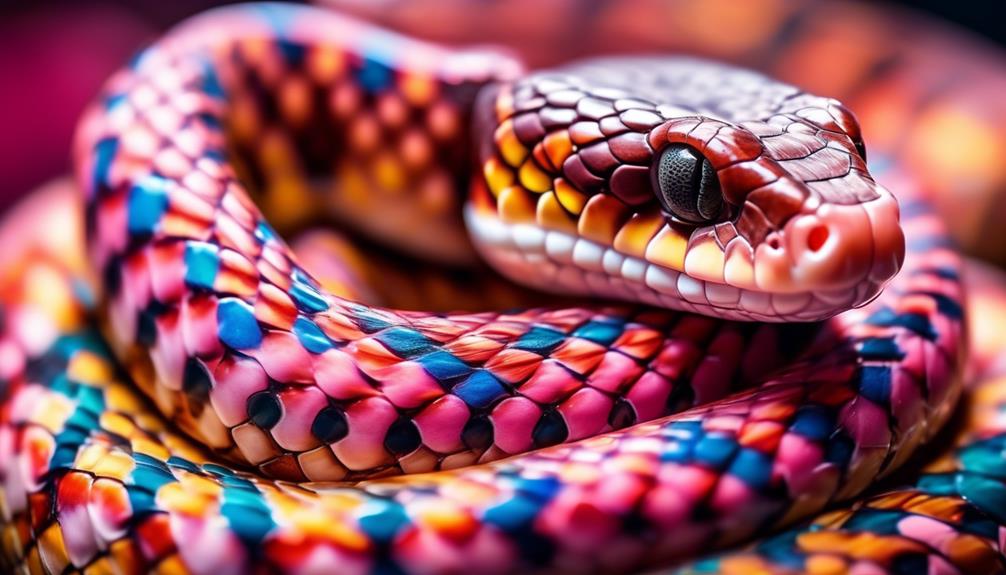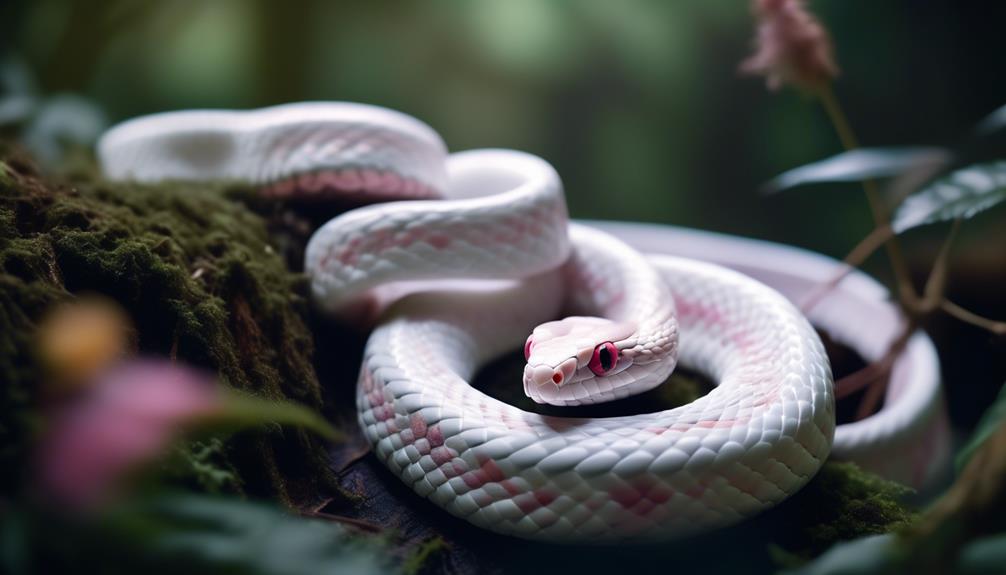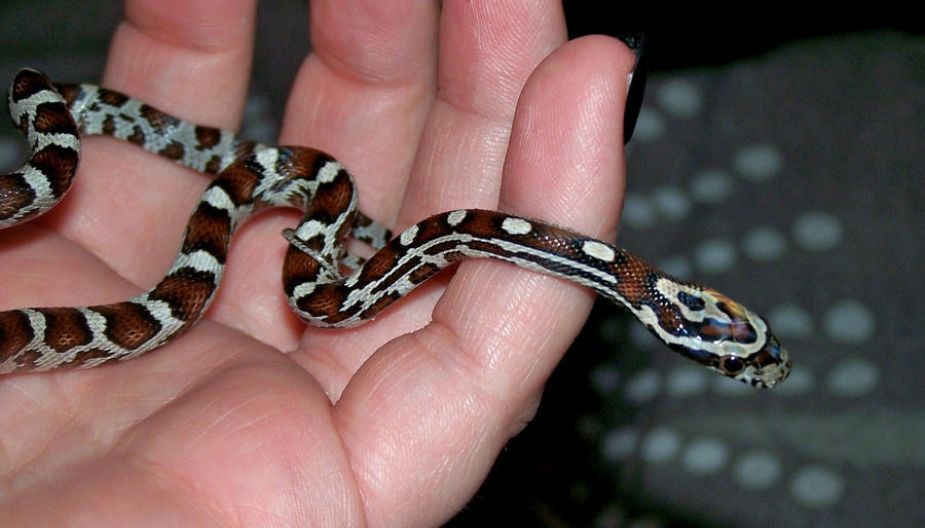As you observe the transformation of a palmetto corn snake, it’s like watching a canvas come to life with a myriad of colors and patterns. From its initial pale pink hatchling stage to its vibrant mosaic masterpiece as an adult, the journey is truly a marvel to witness.
But what exactly causes this stunning metamorphosis, and how can you ensure the health and vitality of your own palmetto corn snake as it develops? Join us as we explore the fascinating stages of development, shedding process, and care tips for these captivating reptiles, and uncover the secrets behind their mesmerizing transformation.
The Pale Pink Hatchling Stage
As a pale pink hatchling, the Palmetto corn snake exhibits a delicate coloration that gradually transforms as it progresses through its early stages of development. During this initial phase, the snake’s growth stages are characterized by rapid changes in size and behavior. The hatchling’s feeding habits primarily consist of small prey such as pinky mice and newborn rats. These meals provide essential nutrients for the snake’s development, supporting its growth and metamorphosis into the vibrant mosaic masterpiece it will become.
At this stage, the Palmetto corn snake is highly active, exploring its environment and displaying natural hunting instincts. The feeding habits of the hatchling are crucial for its survival and overall health, as they directly influence its growth and development. As the snake consumes its prey, it undergoes remarkable changes in its physical appearance, shedding its skin as it grows. This shedding process is a key indicator of the snake’s progression through the growth stages, marking its transition from a delicate pale pink hatchling to a more robust and colorful juvenile snake.
Development of Unique Coloration
Moving from its pale pink hatchling stage, the Palmetto corn snake undergoes a remarkable transformation in its coloration as it progresses through its development. This transformation is influenced by a complex interplay of color genetics and environmental factors.
The unique coloration of the Palmetto corn snake is a result of its genetic makeup, specifically the interaction of various color genes that determine the distribution and expression of pigments in its scales. These color genes can produce a wide array of hues, ranging from vibrant oranges and reds to subtle creams and yellows, contributing to the mosaic-like pattern that makes the Palmetto corn snake a truly remarkable sight.
Furthermore, environmental influences such as temperature and humidity can also impact the development of the snake’s coloration. The conditions in which the snake is raised can affect the intensity and brightness of its colors, adding another layer of complexity to its development.
Understanding the intricate interplay of color genetics and environmental influences provides valuable insights into the fascinating process of how the Palmetto corn snake transforms from a pale pink hatchling into a vibrant mosaic masterpiece.
Shedding and Growth Process
At regular intervals, the Palmetto corn snake undergoes the process of shedding its old skin to accommodate its growth, a critical aspect of its physiological development. The shedding process is a crucial mechanism for the snake to remove old, worn-out skin and reveal a fresh, vibrant new layer underneath.
Here’s what happens during this shedding and growth process:
- Shedding Process: The Palmetto corn snake’s shedding process, also known as ecdysis, begins with the snake’s skin becoming dull and the eyes turning a milky blue color. This is due to a fluid buildup between the old and new skin layers. As the snake’s body secretes a specialized substance, the old skin loosens and the snake wriggles out of it, leaving behind a perfect replica of its body.
- Growth Stages: During the shedding process, the snake’s body undergoes remarkable growth. Its new skin isn’t only fresh and vibrant but also larger, allowing the snake to accommodate its growing body. The shedding and growth process is essential for the Palmetto corn snake to continue thriving and developing into its stunning mosaic masterpiece.
This shedding and growth process is a vital part of the Palmetto corn snake’s life cycle, ensuring its continued health and development.
Care and Husbandry Tips
For proper care and husbandry of the Palmetto corn snake, it’s crucial to create a suitable habitat that mimics its natural environment. Temperature regulation is vital for the overall health and well-being of your Palmetto corn snake. A thermal gradient should be provided within the habitat, with a warm side ranging between 85-88°F and a cooler side around 75-80°F. This allows the snake to regulate its body temperature by moving between the two areas. Additionally, a heat source such as an under-tank heating pad or heat lamp should be used to create these temperature gradients.
When it comes to feeding habits, Palmetto corn snakes are carnivorous and primarily feed on rodents such as mice and rats. It’s essential to provide appropriately sized prey items to ensure proper nutrition and prevent regurgitation. Young snakes should be fed every 5-7 days, while adults can be fed every 7-10 days.
Maintaining a consistent temperature and providing a suitable feeding schedule are crucial aspects of caring for your Palmetto corn snake to ensure its overall health and longevity.
Appreciating the Vibrant Adult Form
The vibrant adult form of the Palmetto corn snake showcases a striking mosaic of colors and patterns, reflecting the culmination of its growth and development.
- Color Genetics: The adult Palmetto corn snake’s vibrant appearance is a result of its unique color genetics. The combination of genes from its parents determines the specific pattern and hues that adorn its scales. This intricate interplay of genetic variations results in the mesmerizing mosaic-like appearance, making each adult Palmetto corn snake a truly one-of-a-kind specimen.
- Natural Habitat: In the wild, adult Palmetto corn snakes inhabit a diverse range of ecosystems, including pine forests, overgrown fields, and coastal hammocks. Their vibrant colors serve as a form of camouflage and aid in their survival by allowing them to blend seamlessly into their natural surroundings. The intricate patterns and colors on their scales provide a fascinating example of evolution’s handiwork, enabling them to thrive in their native habitats.
- Maturity and Brilliance: As the Palmetto corn snake matures, its colors intensify and the patterns become more defined, creating a stunning visual display. This transformation from a pale pink hatchling to a vibrant mosaic masterpiece is a testament to the beauty and complexity of nature’s design.
Frequently Asked Questions
Can Palmetto Corn Snakes Be Kept in the Same Enclosure as Other Snake Species?
Yes, palmetto corn snakes can be kept with other snake species if behavioral compatibility is observed. Enrichment activities and environmental modifications can help create a harmonious environment, but close monitoring is essential to ensure peaceful cohabitation.
How Long Do Palmetto Corn Snakes Typically Live in Captivity?
In captivity, palmetto corn snakes typically live for 15-20 years. They display docile behavior, making them ideal pets. Their average lifespan and calm demeanor make them a rewarding choice for snake enthusiasts seeking a long-term companion.
Are Palmetto Corn Snakes More Prone to Certain Health Issues Than Other Snake Breeds?
Palmetto corn snakes, compared to other breeds, exhibit similar breeding habits and dietary requirements. They are not inherently prone to specific health issues, but like all snakes, proper care and husbandry are crucial for their well-being.
What Is the Best Way to Handle a Palmetto Corn Snake Without Causing Stress or Harm?
When handling a palmetto corn snake, it’s crucial to approach with calm, slow movements to limit stress. Understanding their behavior and using proper handling techniques is essential for stress-free interaction and overall snake care.
Can Palmetto Corn Snakes Be Trained to Interact With Their Owners, or Are They Typically More Reclusive?
Yes, palmetto corn snakes can be trained to interact with their owners. Training methods involve positive reinforcement and gradual exposure to handling. Social interaction can be encouraged through regular, gentle handling techniques, reducing stress and promoting a trusting bond.
Conclusion
As you observe the transformation of the palmetto corn snake from a pale pink hatchling to a vibrant mosaic masterpiece, you witness nature’s artistic prowess at its finest.
The intricate patterns and vivid colors that adorn the adult form are a testament to the marvels of genetic expression.
Like a living canvas, the palmetto corn snake showcases the beauty and complexity of nature’s palette, captivating and inspiring all who behold its mesmerizing appearance.
It’s no wonder that enthusiasts and reptile lovers flock to Freptiles, a leading website brand for in-depth articles and captivating imagery of mesmerizing reptiles.


